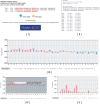PiRaNhA: a server for the computational prediction of RNA-binding residues in protein sequences
- PMID: 20507911
- PMCID: PMC2896099
- DOI: 10.1093/nar/gkq474
PiRaNhA: a server for the computational prediction of RNA-binding residues in protein sequences
Abstract
The PiRaNhA web server is a publicly available online resource that automatically predicts the location of RNA-binding residues (RBRs) in protein sequences. The goal of functional annotation of sequences in the field of RNA binding is to provide predictions of high accuracy that require only small numbers of targeted mutations for verification. The PiRaNhA server uses a support vector machine (SVM), with position-specific scoring matrices, residue interface propensity, predicted residue accessibility and residue hydrophobicity as features. The server allows the submission of up to 10 protein sequences, and the predictions for each sequence are provided on a web page and via email. The prediction results are provided in sequence format with predicted RBRs highlighted, in text format with the SVM threshold score indicated and as a graph which enables users to quickly identify those residues above any specific SVM threshold. The graph effectively enables the increase or decrease of the false positive rate. When tested on a non-redundant data set of 42 protein sequences not used in training, the PiRaNhA server achieved an accuracy of 85%, specificity of 90% and a Matthews correlation coefficient of 0.41 and outperformed other publicly available servers. The PiRaNhA prediction server is freely available at http://www.bioinformatics.sussex.ac.uk/PIRANHA.
Figures


Similar articles
-
Protein function annotation from sequence: prediction of residues interacting with RNA.Bioinformatics. 2009 Jun 15;25(12):1492-7. doi: 10.1093/bioinformatics/btp257. Epub 2009 Apr 23. Bioinformatics. 2009. PMID: 19389733
-
Protein-RNA interface residue prediction using machine learning: an assessment of the state of the art.BMC Bioinformatics. 2012 May 10;13:89. doi: 10.1186/1471-2105-13-89. BMC Bioinformatics. 2012. PMID: 22574904 Free PMC article.
-
BindN: a web-based tool for efficient prediction of DNA and RNA binding sites in amino acid sequences.Nucleic Acids Res. 2006 Jul 1;34(Web Server issue):W243-8. doi: 10.1093/nar/gkl298. Nucleic Acids Res. 2006. PMID: 16845003 Free PMC article.
-
DP-Bind: a web server for sequence-based prediction of DNA-binding residues in DNA-binding proteins.Bioinformatics. 2007 Mar 1;23(5):634-6. doi: 10.1093/bioinformatics/btl672. Epub 2007 Jan 19. Bioinformatics. 2007. PMID: 17237068
-
Applying the Naïve Bayes classifier with kernel density estimation to the prediction of protein-protein interaction sites.Bioinformatics. 2010 Aug 1;26(15):1841-8. doi: 10.1093/bioinformatics/btq302. Epub 2010 Jun 6. Bioinformatics. 2010. PMID: 20529890
Cited by
-
Protein-assisted RNA fragment docking (RnaX) for modeling RNA-protein interactions using ModelX.Proc Natl Acad Sci U S A. 2019 Dec 3;116(49):24568-24573. doi: 10.1073/pnas.1910999116. Epub 2019 Nov 15. Proc Natl Acad Sci U S A. 2019. PMID: 31732673 Free PMC article.
-
Identifying RNA-binding residues based on evolutionary conserved structural and energetic features.Nucleic Acids Res. 2014 Feb;42(3):e15. doi: 10.1093/nar/gkt1299. Epub 2013 Dec 16. Nucleic Acids Res. 2014. PMID: 24343026 Free PMC article.
-
A Graph Approach to Mining Biological Patterns in the Binding Interfaces.J Comput Biol. 2017 Jan;24(1):31-39. doi: 10.1089/cmb.2016.0128. Epub 2016 Nov 28. J Comput Biol. 2017. PMID: 27892693 Free PMC article.
-
Sequence-Based Prediction of RNA-Binding Proteins Using Random Forest with Minimum Redundancy Maximum Relevance Feature Selection.Biomed Res Int. 2015;2015:425810. doi: 10.1155/2015/425810. Epub 2015 Oct 12. Biomed Res Int. 2015. PMID: 26543860 Free PMC article.
-
Comprehensive Survey and Comparative Assessment of RNA-Binding Residue Predictions with Analysis by RNA Type.Int J Mol Sci. 2020 Sep 19;21(18):6879. doi: 10.3390/ijms21186879. Int J Mol Sci. 2020. PMID: 32961749 Free PMC article. Review.
References
-
- Lukong KE, Chang KW, Khandjian EW, Richard S. RNA-binding proteins in human genetic disease. Trends Genet. 2008;24:416–425. - PubMed
-
- Ellis JJ, Broom M, Jones S. Protein-RNA interactions: structural analysis and functional classes. Proteins. 2007;66:903–911. - PubMed
-
- Jeong E, Chung IF, Miyano S. A neural network method for identification of RNA-interacting residues in protein. Genome Inform. 2004;15:105–116. - PubMed

